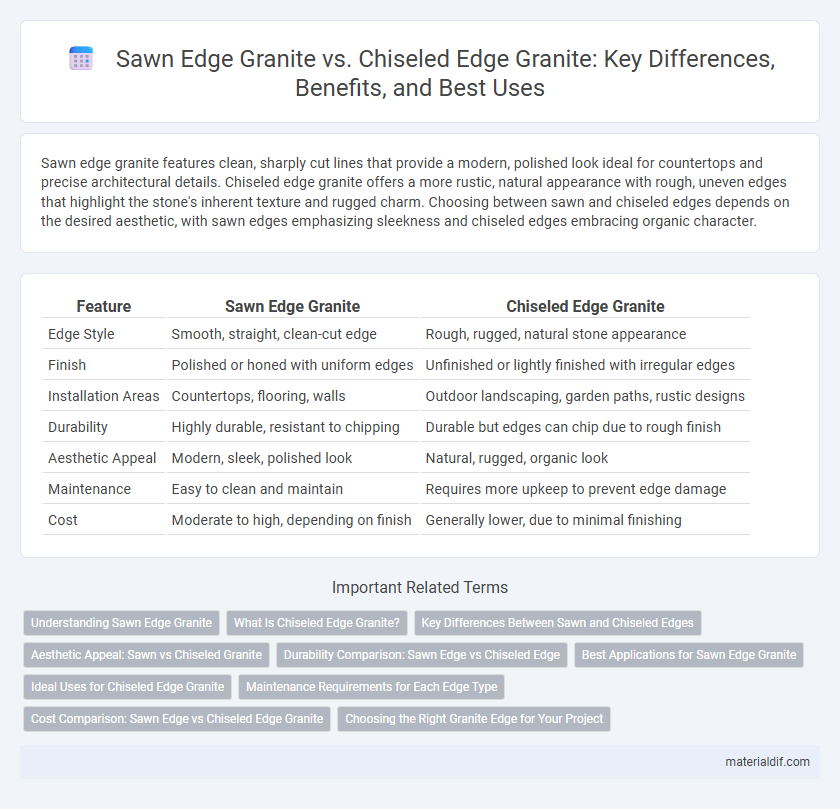Sawn edge granite features clean, sharply cut lines that provide a modern, polished look ideal for countertops and precise architectural details. Chiseled edge granite offers a more rustic, natural appearance with rough, uneven edges that highlight the stone's inherent texture and rugged charm. Choosing between sawn and chiseled edges depends on the desired aesthetic, with sawn edges emphasizing sleekness and chiseled edges embracing organic character.
Table of Comparison
| Feature | Sawn Edge Granite | Chiseled Edge Granite |
|---|---|---|
| Edge Style | Smooth, straight, clean-cut edge | Rough, rugged, natural stone appearance |
| Finish | Polished or honed with uniform edges | Unfinished or lightly finished with irregular edges |
| Installation Areas | Countertops, flooring, walls | Outdoor landscaping, garden paths, rustic designs |
| Durability | Highly durable, resistant to chipping | Durable but edges can chip due to rough finish |
| Aesthetic Appeal | Modern, sleek, polished look | Natural, rugged, organic look |
| Maintenance | Easy to clean and maintain | Requires more upkeep to prevent edge damage |
| Cost | Moderate to high, depending on finish | Generally lower, due to minimal finishing |
Understanding Sawn Edge Granite
Sawn edge granite features precise, clean lines created by cutting the stone with a diamond blade, resulting in a smooth, uniform finish ideal for modern and contemporary designs. This edge type enhances the natural grain and color of granite, offering a sleek and polished appearance that complements countertops and tiles. Sawn edges also provide a consistent thickness and straightness, facilitating seamless installation and alignment in various architectural applications.
What Is Chiseled Edge Granite?
Chiseled edge granite features a rough, natural-looking finish created by hand or machine chiseling, offering a rustic and textured appearance ideal for outdoor or traditional designs. This edge style preserves the stone's natural character by retaining irregularities and uneven surfaces, enhancing visual depth and tactile interest. Unlike sawn edge granite, which has smooth, straight edges from precision cutting, chiseled edge granite emphasizes authenticity and rugged charm in architectural and landscaping projects.
Key Differences Between Sawn and Chiseled Edges
Sawn edge granite features smooth, precise cuts created by advanced cutting machines, resulting in clean, straight lines ideal for modern designs. Chiseled edge granite showcases a rugged, textured finish achieved by manual hammering, providing a natural, rustic appeal favored in traditional or outdoor applications. The key differences lie in their appearance, production technique, and suitability for various architectural styles and durability requirements.
Aesthetic Appeal: Sawn vs Chiseled Granite
Sawn edge granite features a clean, straight cut that highlights the stone's natural grain and color with a modern, polished appearance, making it ideal for contemporary designs. Chiseled edge granite offers a rough, textured finish that enhances the stone's rugged character and provides a rustic or natural look, adding tactile depth to countertops and flooring. The choice between sawn and chiseled edge granite directly influences the aesthetic appeal by balancing smooth elegance against organic roughness, tailoring the stone's visual impact to specific design preferences.
Durability Comparison: Sawn Edge vs Chiseled Edge
Sawn edge granite features a clean, straight cut that maintains the stone's natural strength, offering superior durability compared to the irregular chiseled edge, which introduces minor weaknesses along the fractured surfaces. The precision of sawn edges reduces the risk of chipping and cracking under heavy use, making it ideal for high-traffic areas and countertops. Chiseled edges, though aesthetically rugged, present slightly less resistance to impact and wear due to their uneven texture and exposed grain.
Best Applications for Sawn Edge Granite
Sawn edge granite features smooth, straight lines ideal for modern kitchens, countertops, and flooring where a clean, polished look is essential. Its precise finish enhances installation in contemporary spaces requiring seamless joins and uniform surfaces. Sawn edges resist chipping and provide durability, making them suitable for high-traffic areas and functional surfaces.
Ideal Uses for Chiseled Edge Granite
Chiseled edge granite features a rough, rustic finish that enhances its natural, rugged appearance, making it ideal for outdoor applications such as garden pathways, patios, and retaining walls. Its textured profile provides excellent slip resistance, suitable for pool surrounds and high-traffic exterior areas. Compared to sawn edge granite, chiseled edges complement landscape designs emphasizing organic aesthetics and durability in harsh weather conditions.
Maintenance Requirements for Each Edge Type
Sawn edge granite features a smooth, clean finish that simplifies routine cleaning and reduces dirt accumulation, making it low-maintenance and ideal for kitchens or bathrooms. Chiseled edge granite, with its rough and textured finish, requires more frequent and detailed cleaning to prevent debris buildup in the uneven surfaces, and periodic sealing is recommended to maintain its durability. Both edge types benefit from regular sealing, but the chiseled edge demands more attentive care to preserve its rugged aesthetic.
Cost Comparison: Sawn Edge vs Chiseled Edge Granite
Sawn edge granite typically costs less due to the precision cutting process that minimizes labor and waste, making it a more budget-friendly option. Chiseled edge granite requires skilled craftsmanship to manually shape and texture the surface, increasing labor costs and overall price. Choosing between sawn edge and chiseled edge granite depends on balancing aesthetic preferences with budget constraints, as chiseled edges demand higher investment for their unique rustic appearance.
Choosing the Right Granite Edge for Your Project
Sawn edge granite offers a clean, precise finish ideal for modern countertops and sleek architectural elements, enhancing durability and ease of installation. Chiseled edge granite provides a natural, rustic appearance with irregular contours perfect for outdoor landscaping, garden pathways, and traditional design aesthetics. Selecting the right granite edge depends on project style, maintenance preferences, and the desired visual impact, balancing functionality with aesthetic appeal.
Sawn Edge Granite vs Chiseled Edge Granite Infographic

 materialdif.com
materialdif.com